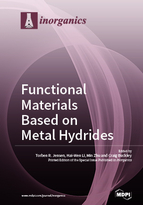Functional Materials Based on Metal Hydrides
A special issue of Inorganics (ISSN 2304-6740). This special issue belongs to the section "Inorganic Solid-State Chemistry".
Deadline for manuscript submissions: closed (30 September 2017) | Viewed by 70540
Special Issue Editors
Interests: synthesis and characterization of inorganic materials; structural, chemical and physical properties; energy storage as hydrogen or electricity in novel types of batteries; multivalent solid state batteries
Special Issues, Collections and Topics in MDPI journals
Interests: hydrogen storage; hydrogen energy; hydride; rechargeable battery materials
Special Issues, Collections and Topics in MDPI journals
Interests: hydrogen storage; microstructure characterization; electrode materials for batteries; materials synthesis by plasma milling
Interests: hydrogen storage; energy storage materials; thermal energy storage materials; metal hydrides; thermodynamics
Special Issues, Collections and Topics in MDPI journals
Special Issue Information
Dear Colleagues,
Our extreme and growing energy consumption, based on fossil fuels, has significantly increased the levels of carbon dioxide, which may lead to global and irreversible climate changes. We have plenty of renewable energy, e.g., sun and wind, but the fluctuations over time and geography call for a range of new ideas, and possibly novel technologies. The most difficult challenge appears to be the development of efficient and reliable storage of renewable energy. Hydrogen has long been considered as a potential means of energy storage; however, storage of hydrogen is also challenging. Therefore, a wide range of hydrogen-containing materials, with energy-related functions, has been discovered over the past few decades. The chemistry of hydrogen is very diverse, and so also are the new hydrides that have been discovered, not only in terms of structure and composition, but also in terms of their properties. This has led to a wide range of new possible applications of metal hydrides that permeate beyond solid-state hydrogen storage. A variety of new hydrides, proposed as battery materials, has been discovered. These can exploit properties as fast ion conductors or as conversion-type electrodes with much higher potential energy capacities, as compared to materials currently used in commercial batteries. Solar heat storage is also an area of great potential with metal hydrides, in principle offering orders of magnitude better storage performance than phase change materials. Recently, hydrides with optical and superconducting properties have also been investigated. This Special Issue of Inorganics, entitled “Functional Materials Based on Metal Hydrides”, is dedicated to the full range of emerging electronic, photonic, and energy-related inorganic hydrogen-containing materials.
Prof. Dr. Torben R. JensenAssociate Prof. Dr. Hai-Wen Li
Prof. Dr. Min Zhu
Prof. Dr. Craig Buckley
Guest Editors
Manuscript Submission Information
Manuscripts should be submitted online at www.mdpi.com by registering and logging in to this website. Once you are registered, click here to go to the submission form. Manuscripts can be submitted until the deadline. All submissions that pass pre-check are peer-reviewed. Accepted papers will be published continuously in the journal (as soon as accepted) and will be listed together on the special issue website. Research articles, review articles as well as short communications are invited. For planned papers, a title and short abstract (about 100 words) can be sent to the Editorial Office for announcement on this website.
Submitted manuscripts should not have been published previously, nor be under consideration for publication elsewhere (except conference proceedings papers). All manuscripts are thoroughly refereed through a single-blind peer-review process. A guide for authors and other relevant information for submission of manuscripts is available on the Instructions for Authors page. Inorganics is an international peer-reviewed open access monthly journal published by MDPI.
Please visit the Instructions for Authors page before submitting a manuscript. The Article Processing Charge (APC) for publication in this open access journal is 2700 CHF (Swiss Francs). Submitted papers should be well formatted and use good English. Authors may use MDPI's English editing service prior to publication or during author revisions.
Keywords
- Hydrides
- Synthesis
- Structural, chemical and physical properties
- Functional energy materials
- Hydrogen Storage
- Ionic Conductivity
- Battery Electrode
- Metal hydride based batteries
- Heat Storage
- Optical Switch
- Superconductivity









